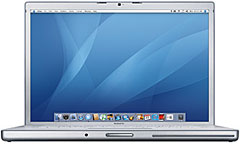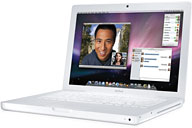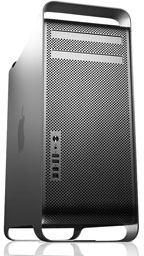2006 was the year Apple moved from PowerPC processors, which it
first started using in 1993, to Intel x86 CPUs. Apple had announced the
forthcoming transition at the June 2005 Worldwide Developer
Conference (WWDC) with the promise that the first Intel-based Macs
would ship within a year.
The first Intel Macs were released in January 2006, months
ahead of expectations, and they were not without a few teething
pains.
The biggest drawback to the new architecture is that for the first
time ever, there was no support for the
Classic Mac OS. For anyone who depended on a Classic app, Intel
Macs became an impossible dream until those apps could be replaced.
The First Intel Macs
The first Macs to make the transition were the iMac, the 15" MacBook
Pro, and the Mac mini, which was just a year old at the time. The
first generation of Intel-based Macs used Intel's Core Duo CPU, and
they were 'wicked fast', to borrow a phrase from the Macintosh IIfx. With two x86 cores
running at 1.66 GHz or better, the Macintel models had a lot more
horsepower than any Mac besides the high-end Power Mac G5 Quad.
The Core Duo iMac
shipped in 17" and 20" sizes with 1.83 GHz and 2.0 GHz speeds
respectively. As was the norm, the entry-level model had a Combo drive
while the top-end iMac boasted a SuperDrive.
The Mac mini also came in two configurations. The base 1.5 GHz Core Solo Mac mini was the
only model Apple ever produced to use a single-core Intel CPU, and it
sold for $100 more than the previous entry-level Mac mini. The top-end
Core Duo Mac mini had a 1.66
GHz CPU and a SuperDrive; it also retailed for $100 more than the model
it replaced.
Unlike most earlier Macs, the Mac mini used "vampire video", which used
up to 80 MB of system memory for graphics. The Intel GMA 950 graphics
processor was pretty lackluster, and the 1.5 GHz Core Solo model was
simply underpowered, earning it the
Road Apple label.
 The 15" MacBook Pro
replaced the 15" aluminum PowerBook, and it looked almost identical.
There was a great hue and cry over the MacBook name, which many
considered a poor replacement for the established PowerBook brand. The
first Intel-based Mac notebook had more than its share of teething
problems, which became evident shortly after it began shipping in
mid-February.
The 15" MacBook Pro
replaced the 15" aluminum PowerBook, and it looked almost identical.
There was a great hue and cry over the MacBook name, which many
considered a poor replacement for the established PowerBook brand. The
first Intel-based Mac notebook had more than its share of teething
problems, which became evident shortly after it began shipping in
mid-February.
Speeds were 1.83 GHz and 2.0 GHz, with a 2.16 GHz build-to-order
option, and it seemed like Apple was revising the MBP almost weekly in
its quest to get things just right. The Core Duo 15" MacBook Pro was
the only MBP without a FireWire 800 port.
Expanding the Line
After Apple worked out all the 15" MacBook Pro issues, it introduced
the 17" MacBook
Pro on April 24 at a 2.16 GHz clock speed. On May 15, Apple moved
the 15" MacBook Pro to 2.0 GHz and 2.16 GHz and introduced a glossy
display option.
 In
mid-May, Apple introduced the widescreen 13.3" MacBook to replace
the older 12" and 14" iBook models. The entry-level model sold for
$1,099 with a 1.83 GHz Core Duo CPU, 512 MB of RAM, a 60 GB hard drive,
and a Combo drive. The midrange MacBook ran at 2.0 GHz, had a
SuperDrive, and sold for $1,299. At the top was a black MacBook with an
80 GB hard drive and a $1,499 price tag. Apple would continue to use
these price points until the Unibody MacBook was introduced
in late 2008.
In
mid-May, Apple introduced the widescreen 13.3" MacBook to replace
the older 12" and 14" iBook models. The entry-level model sold for
$1,099 with a 1.83 GHz Core Duo CPU, 512 MB of RAM, a 60 GB hard drive,
and a Combo drive. The midrange MacBook ran at 2.0 GHz, had a
SuperDrive, and sold for $1,299. At the top was a black MacBook with an
80 GB hard drive and a $1,499 price tag. Apple would continue to use
these price points until the Unibody MacBook was introduced
in late 2008.
The biggest complaint about the MacBook was that it had a glossy
display - matte wasn't even an option. Within two years, glossy
would be the default on all 'Books, although Apple does offer a $50
anti-glare option on the 17" MacBook Pro.
On July 5, Apple introduced a new 17" iMac aimed at the
education market. The 1.83 GHz Core Duo machine used the same "vampire
video" Intel GMA 950 graphics as the entry-level Mac mini and had a
Combo drive.
King of the Macs
 Apple finished moving the
Mac line to Intel on August 7 with the introduction of the Mac Pro, which replaced the
long-running Power Mac line. The new pro Mac used two dual-core Xeon
CPUs (at 2.0, 2.66, or 3.0 GHz) and supported up to 32 GB of RAM.
Apple finished moving the
Mac line to Intel on August 7 with the introduction of the Mac Pro, which replaced the
long-running Power Mac line. The new pro Mac used two dual-core Xeon
CPUs (at 2.0, 2.66, or 3.0 GHz) and supported up to 32 GB of RAM.
Apple improved the Mac
mini on Sept. 6, putting a 1.66 GHz Core Duo CPU in the entry-level
model (mercifully killing off the only Core Solo Mac ever) and moving
the SuperDrive model to 1.83 GHz.
On the same date, the
iMac moved to Intel's newer Core 2 Duo CPU, which included 64-bit
support, and introduced a 24" 2.16 GHz model. The Core 2 is generally
considered to be about 7% more powerful than Core Duo at the same clock
speed, and it supports 64-bit operation, which the Core Duo does
not.
On Sept. 12, Apple introduced a redesigned iPod nano. The 2G nano is
clad in aluminum and was available in 6 different colors.  An overhauled
iPod shuffle was introduced at the same time - far smaller than the
original, which was the size of a pack of gum. The 2G iPod shuffle was
so small that it needed a special cable - there wasn't room for even a
mini USB port.
An overhauled
iPod shuffle was introduced at the same time - far smaller than the
original, which was the size of a pack of gum. The 2G iPod shuffle was
so small that it needed a special cable - there wasn't room for even a
mini USB port.
On Oct. 24, Apple moved the MacBook Pro to Core 2 Duo CPUs. The
15" MacBook
Pro came in 2.16 GHz and 2.33 GHz models, and the 17" MacBook Pro
clocked at 2.33 GHz.
The MacBook
line migrated to Intel Core 2 Duo processors on Nov. 8 with the same
CPU speeds and RAM. The midrange model now had an 80 GB hard drive, and
the new black MacBook moved to 120 GB.
At the end of 2006, the Mac mini was the only Mac left using the
Core Duo CPU.
Next - 2007: Santa Rosa 'Books, iPhone, Aluminum
iMac, and Leopard

 The
The  In
mid-May, Apple introduced the widescreen
In
mid-May, Apple introduced the widescreen  Apple finished moving the
Mac line to Intel on August 7 with the introduction of the
Apple finished moving the
Mac line to Intel on August 7 with the introduction of the  An overhauled
iPod shuffle was introduced at the same time - far smaller than the
original, which was the size of a pack of gum. The 2G iPod shuffle was
so small that it needed a special cable - there wasn't room for even a
mini USB port.
An overhauled
iPod shuffle was introduced at the same time - far smaller than the
original, which was the size of a pack of gum. The 2G iPod shuffle was
so small that it needed a special cable - there wasn't room for even a
mini USB port.
